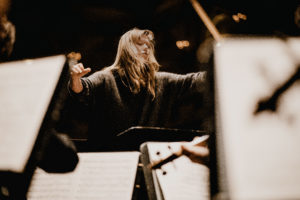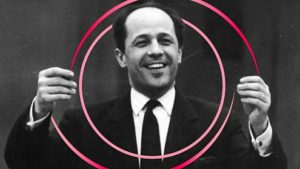
The majority of the “livestream” concerts I have watched during the Covid Lockdown have been pre-recorded and edited. Beethoven’s Legacy: Music Imitates Life at St Stephen’s South Dulwich by contrast was the real thing – a live event. However, based on the numerous technical hitches that the musicians had to deal with you can understand why many other artists have chosen not to put themselves through this pain barrier!
Initially, there were problems with getting the livestream to work so there was a delay at the beginning, then the audio on the artist’s spoken introductions was so quiet that the organisers needed to add subtitles which were very haphazard often relaying only part sentences. I had my ear pressed to the IPad! There were long pregnant pauses between the works (that of course wouldn’t be noticed when you have an audience applauding). Also, the picture quality on the livestream was incredibly grainy. It had me blinking and taking my glasses off to see if it was blurred vision or dirty specs. It wasn’t either. This was a shame as the music itself was really very good and luckily the sound quality when they were playing was not an issue.
The idea of this concert as part of a weekend of events was to explore how composers use music as a retrospective near the end of their lives. In a way that doesn’t really work as only the Viola Sonata by Dmitri Shostakovich was written in the last months of his life. Copland’s Sonata for violin and piano was composed in 1943 (when he was middle aged) and Beethoven’s Moonlight Sonata was written when he was just 31. Copland did transcribe his work for clarinet (as presented here in the concert) when he was in his late 70s but the work was virtually identical.
It does have an association with death though – Copland’s work was dedicated to Lieutenant Harry H Dunham who was shot down over the Pacific during World War II. He was a personal friend and Copland was deeply affected by the loss. However, the dedication only came after the work was completed. That said it does often sound very much like the war time work that it is. There is certainly a great deal of melancholy in the music but also the inevitable war time commitment / New Deal spirit and determination to work together for the common good. It therefore is often compared to Appalachian Spring which he started composing at the same time. Howard Pollack also suggests neoclassical elements.
The three sonatas together worked quite well. All three have three movements: Copland’s is Slow-Fast-Slow/Slow/Fast-Slow, the Beethoven Slow/Faster/Fast and the Shostakovich Slow/Fast/Slow.
Clarinettist Jernej Albreht who curated the weekend of concerts kicked off the show accompanied by pianist Joseph Havlat with the Copland. You had the feel for Albreht. After all the stress of the delayed start he then had a real problem adjusting his reed. This reminded me of a recurring nightmare I used to have – where I was on the first fairway of my local golf club looking for a lost ball and aware of people waiting on the tee. It was like treading water. I used to wake up in a cold sweat! The good news though was that when the music finally got under way it seemed that all the fluster was soon forgotten.
For me, I think I prefer the clarinet reworking as there is greater warmth and it accentuates the jazzy elements. The piece is often cited as one that combines the Copland’s popular idiom with his more difficult work. Indeed there are folk like passages as well as a jazzy swing, the pastoral sound of the open landscape that Copland is so famous for and then some instances the angular, rhythmic, technical music that is more difficult for many of Copland’s typical listeners.
The first part Andante Semplice/Allegro (walking pace, plain/fast) is quite stately and often has a hymn like quality – listen out for the frequent “amen” endings in the piano part. It’s slow and wistful one moment and then builds to cacophonous jazz fanfares the next. It frequently reminds me of 1970s Chick Corea (check out selections from his anthology Works on the ECM label to see what I mean).
Like so much of Copland’s output there is also a real dance quality about this music. It’s odd that of the thirteen of Copland’s non-ballet pieces (including the Piano Variations!) that have been choreographed by dancers that this isn’t one of them. The second movement Lento (slow) is really sparse, crystalline, very precise with lots of space between notes. It puts me in mind of an ice dance competition. Go with me on this! I think it sounds like the long discontinued compulsory figures part of the competition where skaters had to produce circular patterns on the ice to demonstrate skill in placing clean turns evenly on round circles. I have been told that this middle piece sounds so simple but is incredibly difficult to pull off as there is no hiding place if you get it wrong. It really does have the feel of a very slow etude (study) showcasing the technical merit of the players.
The third part Allegretto giusto (medium paced but exact) is a stark contrast being very jaunty and playful. At times the jazz elements do give it that Tom and Jerry soundtrack feel. It’s the most virtuosic part of the whole piece and as a polar opposite of the previous section, the violinist or clarinettist has to restrain themselves somewhat so as not to overdo it and come across as too “show offy”. Following the very busy middle the sonata concludes with the calm, austerity of the beginning which again is a foretaste of the end of Appalachian Spring.
The playing by Albreht and Havlat was excellent – they did a fine job and if I was an old fashioned ice skating judge I think I would award them 5.8 for technical merit and 5.9 for artistic impression! (Just so you know top marks in ice skating back in the 80’s were a perfect 6.0).
The last time I saw Albreht was my last “in the flesh” concert experience at the Sage Gateshead where he played exemplary solos in Music for the Theatre and Gershwin’s Rhapsody in Blue. This reading again indicates that he has a real affiliation for this music and is becoming a fine interpreter. I certainly hope he delves further into Copland’s catalogue. Other pieces that seldom get programmed but are certainly worthy include the Sextet, As it fell upon a day (for soprano, flute and clarinet) and Letter from Home.
Havlat had a very busy evening as he was involved in all three sonatas. I was impressed by his playing throughout. The technical hitch that he had to put up with was a squeaky piano chair or floorboard! This was quite audible and an unfortunate distraction during the slower passages of the Moonlight Sonata.
Jill Valentine accompanied Havlat in the final work, Shostakovich’s Sonata for Viola and Piano, op. 147. This was a new piece for me and I really liked it especially the fast Gypsy inspired scherzo in the middle. If I didn’t know otherwise I would have thought this was a Bartok composition. The slow final adagio really does sound like an epitaph to his musical life – it was composed in the last weeks before he died of lung cancer in 1975. There is an intriguing reference to the Moonlight Sonata at the start of the movement and its long drawn out austere, funereal march bears a resemblance to Copland’s Piano sonata.
One thing that often prevents me loving Shostakovich though is the length of the pieces. As a Copland aficionado I am used to concise works. Apart from his complete ballets, operas and film scores Copland only ever produced two concert works over 30 minutes (Piano Fantasy (just) and Symphony No 3). This offers a massive contrast to Shostakovich whose chamber and piano works frequently are over 30 minutes and his symphonies which often are over an hour in length. I did find myself lulling away in the finale which perhaps was the point but it’s just that this happens quite a lot when I am listening to Shostakovich. I know this will be heretical to some but I am pretty sure Copland would have been a little more choisi.
So in summary a good concert with some fine playing and a few too many dodgy production issues – I hope the next time I see these performers will be with me sitting in an audience which will no doubt improve the experience for all parties.








Leave a Comment